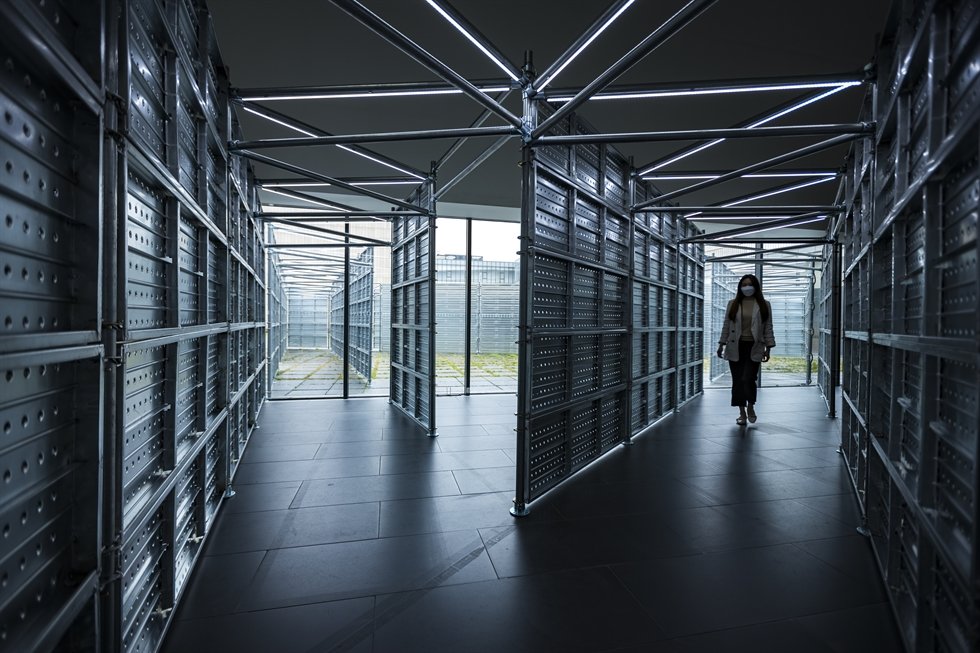Exhibitions explore idea of 'sustainable museum'

Written by Park Han-sol, and published originally by The Korea Times, June 23, 2021.
After opening its doors to the public early last month, the Museum of Contemporary Art Busan (MOCA Busan) is holding an exhibition called, "Sustainable Museum: Art and Environment," which addresses head-on the complex relationship between staging art exhibitions and the unseen environmental impact of such events.
The curatorial decision is inspired by the fundamental fact that "resource-intensive spectacles," such as exhibitions, under the current museum system have not properly dealt with the issue of sustainability.
On one of its walls, the MOCA Busan brings to attention the largely unnoticed, yet real example of the environmental problems facing many art galleries around the world.
"A total of six artworks depart from New York and arrive at the MOCA Busan. The combined weight of the artworks is 1,273 kg. John F. Kennedy International Airport (JFK) in New York is around 11,000 km from Incheon International Airport (ICN). During transportation by air, 15.98 tons of carbon dioxide emissions are generated."
It adds that if the same six artworks are transported by sea, the delivery would take four times longer, but emit approximately 1/40 of the carbon dioxide than if by air. But in the end, almost all art museums prefer air transport.
In order to minimize the amount of air transport, the museum chose either to livestream the pieces located remotely or reproduce the installations based on the production manual. It also skipped the usual painted partitions and instead adopted wooden panels and walls on which to hang the artworks, so as to facilitate reusing these materials.
The text explanations were handwritten on scrap paper, while no paper posters or invitations were handed out. One of the show's highlights is a heap of waste produced from previous exhibitions in its raw form standing side-by-side with the artworks.
"Good art is mindful of the entire process. How to create art is important, but how art is preserved or discarded is equally important," the museum's "Manifesto of a Sustainable Museum" reads.

The Daelim Museum's "Tong's Vintage: The Strange Tongui General Store" in Jongno District, Seoul, transforms the gallery space into a curiosity shop, packed with old, discarded items that have been granted a new life at the hands of the participating artists.
The particular arrangement of the exhibition's seven sections evokes the question of humanity's ecological responsibility ― glass, plastic, iron, fabric, wood, paper and biodegradable materials, ordered from the base materials that take the longest to decompose to the quickest.
From stools made using scrap fabric from a disposable face mask factory, a wall overlaid with obsolete metal traffic signs that have been damaged in traffic accidents, to mini sofas made of goose down jackets that have been discarded despite being in almost perfect condition, the exhibit aims to remind viewers of our urgent need to respond to climate change in a casual and engaging setting.

The pandemic-themed "Catastrophe and Recovery" exhibition at the National Museum of Modern and Contemporary Art, Korea (MMCA) urges viewers to engage in thoughtful contemplation about the present conditions as a way to finding a path to a sustainable future. This message of sustainability is seen notably in the architect Seo Seung-mo's piece as well as the interior design of the exhibition.
Seo's large-scale installation, "Vanishing Line. Sea," was made by erecting metal scaffolding used at construction sites.
"After the exhibition ends in August, this will be disassembled and can be re-used in its entirety with almost no waste, except for the joints," curator Yang Ok-kum told The Korea Times. "As it can be re-used without additional treatment, it's ideal ecologically, and even more sustainable than recycling."
The design of the screening room featuring Jonathan Horowitz's 20-minute video, "Apocalypto Now," equally reflects environmental concerns as the MMCA, at the request of the activist-artist, constructed the outer walls of the room using discarded partitions and panels from an exhibit in its Gwacheon building earlier this year.
Due to the featured videos playing in a loop throughout the exhibition's running time, which produces a significant amount of electricity, and in turn, a carbon footprint, the museum also purchased certified emissions reduction (CER) units, or carbon credits, as a measure of the environmental impact of the project.
"We are mindful of the volume of waste produced every time an exhibition, which naturally doesn't last forever, is finished. And I think we are addressing that concern, at least partially, within the gallery space," Yang noted.